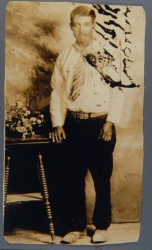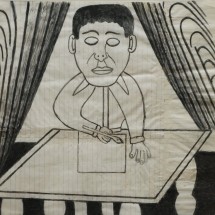Martín Ramírez (Mexican, 1895–1963)

Late 1920s, photo courtesy of the Estate of Martín Ramírez
Ramírez has posthumously gained widespread fame and recognition as one of today’s most significant Outsider artists. An illegal Mexican immigrant and diagnosed schizophrenic, Ramírez spent most of his time in America confined within the walls of the DeWitt State Hospital in California. While institutionalized, Ramírez began to draw regularly. While some of his work was sent to his family in Mexico, most of it was thrown out or burned by the hospital staff. It was the psychologist, Tarmo Pasto, who first encouraged Ramírez’s artistic endeavors. With many of Ramírez’s surviving pieces in his possession, Pasto continued to promote the artist’s work even after his death. Laden with Mexican Catholic iconography and images of the California railroad, Ramírez’s work reflects the difficult experiences faced by the artist during his lifetime. He had a deep, ongoing fascination with trains and train tunnels, which, after horseback riders, are the most frequent subject in his art. Much of his work depicts long trains emerging from mountains, slithering snakelike over long tracks, crossing a dark abyss over bridges, or running through tunnels that connect Jalisco and California—the two worlds in which Ramírez lived. Here, undulating lines that repeat in the upper corners and along the bottom edge of the composition echo the shape of the small, shadowy tunnel openings along train tracks. In the center of the composition, the seated figure is assumed to be a self-portrait seated before a blank page soon to be made into a drawing.
- Untitled, ca. 1960-63

